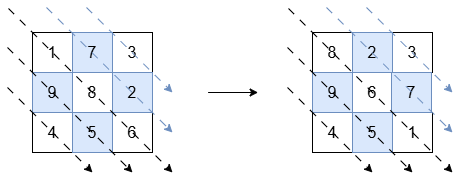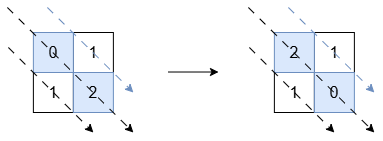矩阵相关 matrix 1351, 6,73, 3446
Given a m x n matrix grid which is sorted in non-increasing order both row-wise and column-wise, return the number of negative numbers in grid.
Example 1:
Input: grid = [[4,3,2,-1],[3,2,1,-1],[1,1,-1,-2],[-1,-1,-2,-3]] Output: 8 Explanation: There are 8 negatives number in the matrix.
Example 2:
Input: grid = [[3,2],[1,0]] Output: 0
Constraints:
m == grid.lengthn == grid[i].length1 <= m, n <= 100-100 <= grid[i][j] <= 100
解法1: O(MN)
class Solution: def countNegatives(self, grid: List[List[int]]) -> int: count = 0 def dfs(x, y): if x < 0 or y < 0 or grid[x][y] >= 0: return nonlocal count count += 1 grid[x][y] = 1 dfs(x - 1, y) dfs(x, y - 1) m, n = len(grid), len(grid[0]) dfs(m - 1, n - 1) return count
解法2:O(MlogN)
class Solution: def countNegatives(self, grid: List[List[int]]) -> int: def bs(row: List[int]): left, right = 0, len(row) - 1 result = -1 while left <= right: mid = left + (right - left) // 2 if row[mid] >= 0: left = mid + 1 else: result = mid right = mid - 1 return result total = 0 for row in grid: pos = bs(row) if pos >= 0: total += len(row) - pos return total
解法3: O(M+N)
class Solution: def countNegatives(self, grid: List[List[int]]) -> int: m = len(grid[0]) #定义最后一个不小于0的位置 currPos = m - 1 result = 0 for row in grid: #如果小于0,那么向左移动。 #思考为什么要这样?因为整个矩阵是从左到右,从上到下递减的 while currPos >= 0 and row[currPos] < 0: currPos -= 1 result += m - currPos - 1 return result
"PAYPALISHIRING" is written in a zigzag pattern on a given number of rows like this: (you may want to display this pattern in a fixed font for better legibility)P A H N A P L S I I G Y I R
And then read line by line: "PAHNAPLSIIGYIR"
Write the code that will take a string and make this conversion given a number of rows:
string convert(string s, int numRows);
Example 1:
Input: s = "PAYPALISHIRING", numRows = 3 Output: "PAHNAPLSIIGYIR"
Example 2:
Input: s = "PAYPALISHIRING", numRows = 4 Output: "PINALSIGYAHRPI" Explanation: P I N A L S I G Y A H R P I
Example 3:
Input: s = "A", numRows = 1 Output: "A"
Constraints:
1 <= s.length <= 1000sconsists of English letters (lower-case and upper-case),','and'.'.1 <= numRows <= 1000
关键点:
1.实际不需要考虑左右位置问题,关键归属哪行,最后是要合并到一起输出,并没有zigzag空格
2.找到规律,每次都是从row=0开始向下走,到了row=numRows-1又开始向上走
class Solution: def convert(self, s: str, numRows: int) -> str: #如果只有一行,那么直接输出 if numRows == 1: return s #否则申请一个numRows大小的二维list arr = [[] for i in range(numRows)] step = 1 row = 0 for c in s: arr[row].append(c) row += step #如果到了最后一行那么向上返 if row == numRows - 1: step = -1 #如果到了第一行,那么向下走 elif row == 0: step = 1 #最后将二维str join起来 return ''.join([ele for sublist in arr for ele in sublist])
Given an m x n integer matrix matrix, if an element is 0, set its entire row and column to 0's.
You must do it in place.
Example 1:

Input: matrix = [[1,1,1],[1,0,1],[1,1,1]] Output: [[1,0,1],[0,0,0],[1,0,1]]
Example 2:

Input: matrix = [[0,1,2,0],[3,4,5,2],[1,3,1,5]] Output: [[0,0,0,0],[0,4,5,0],[0,3,1,0]]
Constraints:
m == matrix.lengthn == matrix[0].length1 <= m, n <= 200-231 <= matrix[i][j] <= 231 - 1
Follow up:
- A straightforward solution using
O(mn)space is probably a bad idea. - A simple improvement uses
O(m + n)space, but still not the best solution. - Could you devise a constant space solution?
1.使用第一行/第一列来标识某行/某列是否存在0
2.问题是这样会导致我们无法判定第一行/第一列是否存在0,使用row0和col0来标识
class Solution { public void setZeroes(int[][] matrix) { if(matrix==null || matrix.length==0 || matrix[0].length==0) return; boolean row0=false,col0=false; for(int i=0;i<matrix.length;i++){ for(int j=0;j<matrix[0].length;j++){ if(matrix[i][j]==0){ if(i==0) row0=true; if(j==0) col0=true; matrix[0][j]=0; matrix[i][0]=0; } } } for(int i=1;i<matrix.length;i++){ for(int j=1;j<matrix[0].length;j++){ if(matrix[i][0]==0 || matrix[0][j]==0) matrix[i][j]=0; } } if(col0) for(int i=0;i<matrix.length;i++) matrix[i][0]=0; if(row0) for(int i=0;i<matrix[0].length;i++) matrix[0][i]=0; } }
You are given an n x n square matrix of integers grid. Return the matrix such that:
- The diagonals in the bottom-left triangle (including the middle diagonal) are sorted in non-increasing order.
- The diagonals in the top-right triangle are sorted in non-decreasing order.
Example 1:
Input: grid = [[1,7,3],[9,8,2],[4,5,6]]
Output: [[8,2,3],[9,6,7],[4,5,1]]
Explanation:

The diagonals with a black arrow (bottom-left triangle) should be sorted in non-increasing order:
[1, 8, 6]becomes[8, 6, 1].[9, 5]and[4]remain unchanged.
The diagonals with a blue arrow (top-right triangle) should be sorted in non-decreasing order:
[7, 2]becomes[2, 7].[3]remains unchanged.
Example 2:
Input: grid = [[0,1],[1,2]]
Output: [[2,1],[1,0]]
Explanation:

The diagonals with a black arrow must be non-increasing, so [0, 2] is changed to [2, 0]. The other diagonals are already in the correct order.
Example 3:
Input: grid = [[1]]
Output: [[1]]
Explanation:
Diagonals with exactly one element are already in order, so no changes are needed.
Constraints:
grid.length == grid[i].length == n1 <= n <= 10-105 <= grid[i][j] <= 105
class Solution { public int[][] sortMatrix(int[][] grid) { int m = grid.length; Map<Integer, List<Integer>> g = new HashMap<>();
// 按diagonal收集元素 for(int i = 0; i < m; i++) { for(int j = 0; j < m; j++) { g.computeIfAbsent(i - j, k -> new ArrayList<>()).add(grid[i][j]); } }
// 排序 for(int i = -m + 1; i < m; i++) { if(i >= 0) Collections.sort(g.get(i), (x, y) -> y - x); else Collections.sort(g.get(i), (x, y) -> x - y); } // 元素回填 for(int i = 0; i < m; i++) { for(int j = 0; j < m; j++) { grid[i][j] = g.get(i - j).get((i + j - Math.abs(i - j)) / 2) ; } } return grid; } record Pos(int x, int y){ } }
空间优化:
class Solution { public int[][] sortMatrix(int[][] grid) { int m = grid.length, n = grid[0].length; int k = m + n - 1; for(int i = 1; i <= k; i++) { // 计算起始点位置 int xs = Math.max(i - m, 0), ys = Math.max(n - i, 0); List<Integer> list = new ArrayList<>(); // 收集元素 int x = xs, y = ys; while(x >= 0 && x < m && y >= 0 && y < n) { list.add(grid[x++][y++]); } // 排序 if(i >= m) Collections.sort(list, (a, b) -> b - a); else Collections.sort(list); // 回填 x = xs; y = ys; int ind = 0; while(x < m && x >= 0 && y >= 0 && y < m) { grid[x++][y++] = list.get(ind++); } } return grid; } }





 浙公网安备 33010602011771号
浙公网安备 33010602011771号